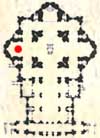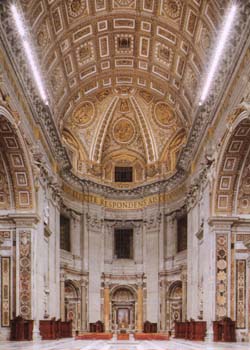| Grottoes
Vatican City Colonnade Saints Floorplan #2 |
| Altars
Monuments The History |
| Related
Items Right Transept St Peter Altar St Joseph Altar |
|
Daily masses are held in the left transept at the central altar dedicated to St. Joseph. The schedule is posted at the entrance to the Sacristy. On the left side is the Altar of the Crucifixion of St. Peter, thought to be nearest the spot where the Apostle died in the Circus of Nero. Against a golden background on the trabeation the inscription reads: "Dicit ter tibi, Petre, Iesus: Diligis me? Cui ter, o electe, respondens ais: O Domine, tu omnia nosti, tu scis quia amo te" ("A third time, Jesus asked him, 'Simon, son of John, do you love me?' 'Yes, Lord', Peter said, 'You know that I love you'") (Jn 21:17) |
From: 'St. Peter's - Guide to Basilica and Square'
The left transept resembles a chapel, open to all, but reserved for recollection
and prayer. On weekdays, the basilica's scheduled Masses are celebrated
at the main altar, dedicated to St. Joseph, at: 10, 11 and 12. On Sundays,
only one Mass is celebrated at 13:00. Communion is also distributed here
to the faithful who ask for it. The Blessed Sacrament, a memorial of Christ's
love for us until the end of time, is constantly preserved in the Tabernacle.
All the faithful who enter the basilica pass here and genuflect before
the Blessed Sacrament, pausing a few moments, kneeling or sitting in the
pews, to pray.
There are three altars. The Central Altar was previously dedicated to the Holy Apostles, Simon and Jude, and Thaddeus, whose relics are preserved in an ancient sarcophagus. John XXIII dedicated it to St. Joseph, Mary's husband and the putative father of Jesus. The mosaic which now decorates the altar was designed by A. Funi (1890-1972), and shows St. Joseph. Flanking the altar are two oval mosaic portraits of the two Apostles, after paintings by Vincent Camuccini.
One the right is the Altar of St. Thomas above which is a mosaic altarpiece inspired by a painting of the Disbelief of the Apostle Thomas, by Vincent Camuccini (1771-1844). The relics of Pope St. Boniface IV who consecrated the Pantheon for Christian worship are kept beneath the altar.
On the left is the Altar of the Crucifixion of St. Peter, with a mosaic reproduction of a picture by Guido Reni (1575-1642) showing St. Peter crucified upside down. An ancient tradition claims that St. Peter suffered martyrdom precisely where the altar stands. In fact part of the basilica is actually built on the site of Nero's Circus.
From:
'St. Peter's Basilica - A Virtual Tour' by Our
Sunday Visitor
Entering now the left transept, one of the arms of the Greek cross, once
known as the Tribune of St. Simon and St. Jude Apostles, due to the two
saints' relics, whose remains, transferred from the St. Agnes mausoleum
dating from Constantine's time, lie under the high altar. On the vault
of this southern Tribune, as in the one on the opposite northern side,
there are valuable stucco and gold decorations by Luigi Vanvitelli, with
three representations in stucco, taken from Raphael's tapestries and illustrating
the "Miraculous Catch," the "Healing of the Cripple" and the "Punishment
of Ananias and Sapphira."
Also to be admired is the very elegant crafting of the capitals crowning the columns at the sides of the altars, in fluted porphyry, yellow and ancient yellow granite. The last of these flank the central altarpiece while two identical ones flank the corresponding altar dedicated to St. Processo and St. Martiniano in the opposite right hand transept.
From:
'THE NEW SAINT PETER'S'
The third arm of Michelangelo's Greek cross is focused on the south tribune,
called that of Saints Simon and Jude, and contains, besides the immense
vault decorated by Vanvitelli and Maini, three altars decorated with rare
marbles.


